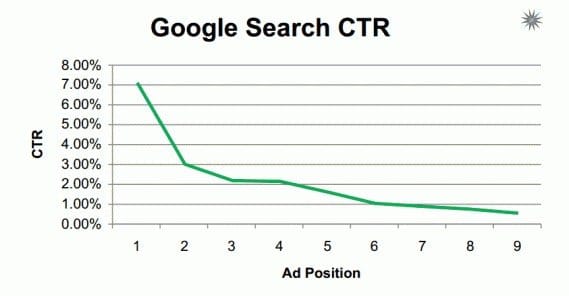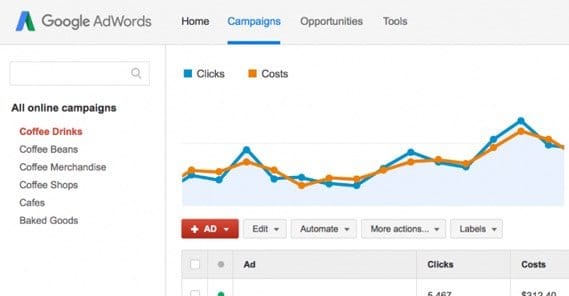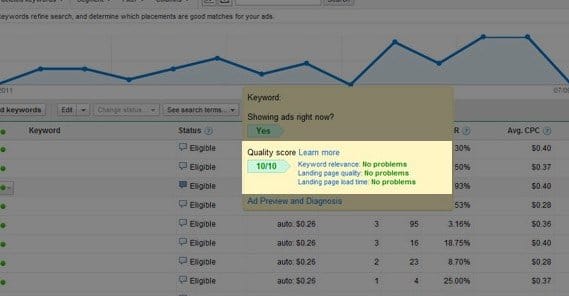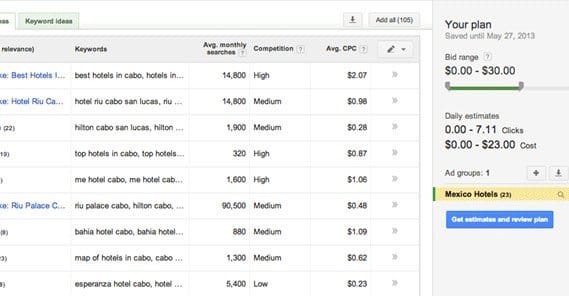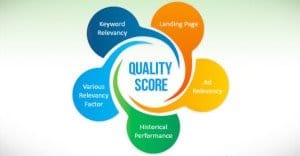How to Increase Your Position in Google AdWords Listings

Position in AdWords listings is a surprisingly complex subject, and it’s something many people don’t think about when they go into it. Many people treat it like organic search results, and assume that being in the number one spot is the best possible outcome. The fact is, it may not be ideal, for reasons other than traffic.
Positions, Traffic, and Costs
You can’t argue with the fact that the top position gets more traffic. Studies from a couple years back show that the top position ad gets a click rate of around 7.1%, and the second position gets less than half of that, at 3%. Position nine, all the way down, gets just slightly over half a percent, at .55%. Now, this is old data, but it’s still going to hold true in a general sense. The top position gets more attention, more traffic, and more clicks.
However, that kind of traffic comes at a price. The top position has the most competition and will cost the most to reach. It’s highly sought after, and thus many people try to bid their way to the top.
The metric you need to monitor when dealing with AdWords is not the specific traffic you get, nor the volume of clicks. It’s the cost per click, or the cost per lead, depending on the purpose of your ad. A position at the top spot might get 2x as much traffic and clicks as the second spot, but if it costs 3x more, it’s not worth it.
That said, there’s always room for improvement. You may not have the budget to shoot for the top spot, but you can always try to improve yourself from rank six to rank two, or something of the sort. Even if number one isn’t attainable, number two may be, and any improvement is better than no improvement.
Factors for Calculating Ad Rank
There are essentially four factors that go into calculating your position for AdWords ads. A fifth – ad extensions – technically has an effect, but it’s so minor it’s not worth considering as a way to improve your position. However, it’s worth talking about, and I’ll mention it again later.
The four factors that influence your ad ranking are:
- Your Max CPC.
- Your Ad Quality Score
- Your Landing Page Usability
- Your Ad Competition
You can affect some of these more easily than others. Let’s look at each of them and see what you can do to improve them, and thus improve your ad positioning, shall we?
Improving AdWords Rank Through Bidding
Bidding is the easiest option to control to improve your ranking, but it’s also not the best option. The reason is, as I mentioned above, the problem of costs. If you triple your bid but only double your conversions, you’re wasting money. Bidding can bump you from rank 9 to rank 5 to rank 3 quite easily in most niches, but trying to rely on bidding to jump to number 1 is going to have intensely diminishing returns.
Bidding is at once the easiest and hardest aspect of AdWords ranking to manipulate. It is, after all, incredibly easy to change your bid upwards and adjust it, cent by cent, until you find your ads in position one.
On the other hand, you have a bunch of limiting factors. For example, do you actually have the budget to support clicks of that price? Remember that the top position – if that’s what you’re going for – is likely to be quite a bit more expensive than position 2. Heck, for that matter, the top five positions are all likely to be quite expensive in high volume, high competition niches. The more competition there is for a given keyword, the more you’re going to have to pay per click and per position. You also never know when a big brand is going to swoop in and claim the top spot with a bid significantly higher than you could possibly pay.
There’s a concept out there called bidding to position. The idea is that you have a specific position you want to reach, whether it’s position one, position two, or position five, whatever. It’s virtually impossible to do by hand, because you need to constantly be checking statistics, positions, and bids, and making adjustments in hopes that it will work for you. Instead, people use scripts to do the work for them. This is one of the most recent and up to date examples of a script. It’s actually produced by Google, so you know it’s legit, and not something they’ll ban you for using.
So, you can think of it this way. To attain a rank you want, you can throw money at it until you reach it. However, you’re going to have to keep on your toes. Other people will be adjusting their bids as well, and in some cases you’ll end up in a bid war between scripts like this one, which can spiral into maximized bids very quickly. To minimize the fallout of this happening, you need to set a maximum bid that is the absolute most you’re willing to pay for a position. Otherwise it can and will raise your bid far beyond the point where you have any desire to pay for it.
Improving AdWords Rank Through Quality Score
In order to make the most of your ad positions, and of your ads themselves, you need to have a high quality score. You can think of quality score as a sort of multiplier or cheat code for AdWords. The better your quality score, the more leeway you’re given with your ads, and the more distance each dollar you bid will go. You can actually “outbid” someone whose actual monetary bid is higher than yours just by having a higher quality score.
Quality score is made up of a bunch of different factors itself. It takes into consideration your ad click-through rates, the relevance of the ad text to the keyword, the relevance of the landing page to the keyword, and your AdWords performance in the past, aggregated. It’s this last factor in particular that can make quality score difficult to improve, if you have a lengthy history of not paying attention to it. It’s simple inertia; more mass to move, takes more energy to move it.
For the most part, improving your quality score simply means improving your relevance. If the keyword you’re targeting is “Flashlights” you probably want ad copy about the best flashlights you offer for sale. Ad copy about repairing flashlights probably won’t do so well. Ad copy about lanterns or oil lamps will do quite poorly. Ad copy about socks won’t be relevant at all.
One of the ways you can improve quality score is by improving click rates. One tool you have for click rate improvement is ad extensions, which I’ll cover later.
Improving AdWords Rank Through Landing Pages
Landing page relevance is part of your quality score, but there’s an independent aspect of landing pages that Google tracks independently from quality score. This aspect is usability. Google wants to make sure that when users click or tap on your ad and visit your site, they’re greeted with a useful page with functionality they can use. This isn’t generally a problem for desktop pages, since the whole web is based around them, but it can be an issue if your site isn’t designed to cater to mobile users.
Mobile usability is becoming increasingly important in marketing. Many people use smartphones or other smart devices to do their browsing, and these devices have specific needs. There are people who don’t even have desktop or laptop PCs these days. If one of these users taps on one of your ads and they’re taken to a page with tiny, zoomed out text and a bunch of forms to fill out, they’re not going to do anything more than back out of the page. You really need a page designed for mobile, with a responsive design, if you want to capture the most of your ad traffic.
You get a series of benefits from catering to mobile. In addition to improving your usability, you improve your relevance, and you improve your conversion rates. You make mobile users a lot more likely to return to your site.
Improving AdWords Rank Through Competition
Competition is difficult to manipulate. You can’t exactly get rid of your competition, you can’t hurt their quality score, and you can’t manipulate their budgets. In fact, the only way to manipulate your competition at all is to try to avoid them. This is where keyword research comes into play.
Your goal is to find keywords that your competition hasn’t found, or that they don’t pump money into. These keywords need to be relevant to your business and your products, and they need to have a decent volume, but they can’t be too large or too generic. Those are likely to have too much competition.
I can’t give you any precise tips about keyword research here, it’s simply too large a topic, and I don’t want to leave something half-explained and mislead you accidentally. Suffice it to say that your specific keyword research is going to depend on your ad goals and your industry, and that there are quite a few tools out there you can use to make things easier.
A Note About Ad Extensions
I’ve said twice that I would talk about ad extensions, and here we are. Ad extensions are essentially add-ons to your ads that go beyond the usual title-URL-description trifecta of information. You’ve probably seen them and simply not noticed them before.
Ad extensions are also more or less automatic. They only appear when you have the appropriate data set on your page, when your ad rank is high enough, and when Google’s algorithms determine that an extension is likely to improve the performance of your ads. This means your ads need to be focused in a way that an extension will improve them. Thankfully, ad extensions don’t cost anything to add, they’re just bonuses that can attract more clicks and thus more engagement.
Here are the possible extensions that can appear:
- A special “download app” link. This only works for mobile devices and mobile users, and it only works if your ad is focused on providing an app to users.
- A call now button. This works on mobile and desktop, and requires that Google knows what phone number is the one the user would want to call. This tends to work best for lead-focused and service-focused ads.
- Address information. This is a special link that takes the user to Google Maps and shows where your location is. It’s best used for ads trying to get people to visit your location, such as for a restaurant. While it works for both desktop and mobile users, it’s arguably more beneficial for mobile ads.
- Review information. If you have reviews for your business from high profile third party sources – not Google places, but industry sites and journals – a segment of that review may be shown. You can read more about reviews here.
- Sitelinks. These are specific links to sub-pages of your site aimed at various tasks. This tends to be best used for ads for your brand name, where the user could have a variety of different purposes in mind.
- Callouts. These are essentially feature bullet points, like “free shipping” and “price matching.” Obviously, they only work if you offer those additions or deals.
- Customer ratings. Like reviews, this shows aggregated review data with ratings, usually out of 5 or 10, depending on the site Google is pulling data from.
- Previous Visit information. This allows Google to inform a user if they’ve visited your site in the past, so they remember that they did in fact trust you enough to click before. Think of it like a minor bit of remarketing.
Ad extensions won’t directly improve your ad ranking, but they can improve your click-through rates, which will improve your ranking overall as they improve. It’s worth setting them up to use when you can.
 ContentPowered.com
ContentPowered.com
